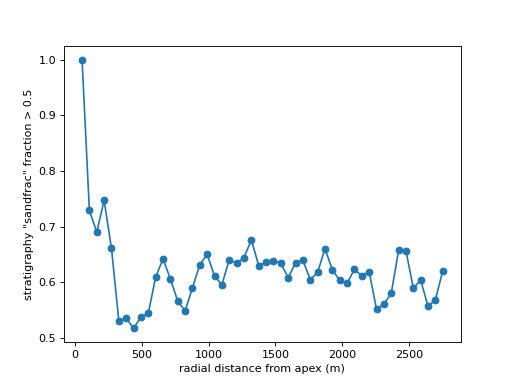Computing a sedimentograph for sand fraction and for preserved time¶
In this example, we explore the sedimentograph [1]. The sedimentograph is a measure of sand fraction of delta stratigraphy. In this implementation, a series of concentric CircularSection are drawn with increasing radius, so the sedimentograph is a function of space.
First, a simple example of computing the sedimentograph, using the compute_sedimentograph function.
By default, the function will generate two bins for the data input for the sediment_volume argument, with the bin divider in the data-range midpoint (i.e., 0.5 for sandfrac data).
# set up the data source
golfcube = dm.sample_data.golf()
golfstrat = dm.cube.StratigraphyCube.from_DataCube(golfcube, dz=0.05)
background = (golfstrat.Z < np.min(golfcube['eta'].data, axis=0))
frozen_sand = golfstrat.export_frozen_variable('sandfrac')
(sedimentograph,
section_radii,
sediment_bins) = dm.strat.compute_sedimentograph(
frozen_sand,
num_sections=50,
last_section_radius=2750,
background=background,
origin_idx=[golfcube.meta['L0'], golfcube.meta['CTR']])
fig, ax = plt.subplots()
ax.plot(
section_radii,
sedimentograph[:, 1], # plot only the second bin (sandfrac > 0.5)
'o-')
ax.set_xlabel('radial distance from apex (m)')
ax.set_ylabel('stratigraphy "sandfrac" fraction > 0.5')
plt.show()
(Source code, png, hires.png)

We can mask a portion of the domain, and compute the sedimentograph over just a portion of the domain. The result is a (only slightly) different sedimentograph.
GM = dm.mask.GeometricMask(
golfcube['eta'][-1],
angular=dict(
theta1=np.pi/8,
theta2=np.pi/2-(np.pi/8))
)
GM_mask_strat = np.tile(GM.mask, (golfstrat.shape[0], 1, 1)) # a mask with same dimensions as stratigraphy
frozen_sand_mask = frozen_sand.where(GM_mask_strat, np.nan)
(sedimentograph2,
section_radii2,
sediment_bins2) = dm.strat.compute_sedimentograph(
frozen_sand_mask,
num_sections=50,
# last_section_radius=2750,
sediment_bins=None,
background=background,
origin_idx=[3, 100])
# add this line to the same plot as above
ax.plot(
section_radii2,
sedimentograph2[:, 1], # plot only the second bin (sandfrac > 0.5)
'o-')
plt.show()
(Source code, png, hires.png)

Using the sedimentograph to evaluate time distribution in subsurface¶
time_bins = np.linspace(0, float(golfcube.t[-1]), num=7)
(time_sedimentograph,
time_radii,
_) = dm.strat.compute_sedimentograph(
golfstrat['time'],
num_sections=50,
last_section_radius=2750,
sediment_bins=time_bins,
background=background,
origin_idx=[3, 100])
import matplotlib
cmap = matplotlib.colormaps['viridis'].resampled(6)
cycler = matplotlib.cycler('color', cmap.colors)
fig, ax = plt.subplots()
ax.set_prop_cycle(cycler)
lines = ax.plot(
time_radii,
time_sedimentograph,
'o-')
ax.set_ylim(0, 1)
time_bin_labels = [f"{time_bins[b]/1e6:.1f}--{time_bins[b+1]/1e6:.1f} million seconds" for b in np.arange(len(time_bins)-1)]
ax.legend(lines, time_bin_labels)
ax.set_xlabel('radial distance from apex (m)')
ax.set_ylabel('stratigraphy fraction in time bin')
plt.show()
(Source code, png, hires.png)
